Gonville and Caius College, Cambridge
Gonville & Caius College (often referred to simply as Caius /kiːz/ KEEZ[3]) is a constituent college of the University of Cambridge in Cambridge, England. The college is the fourth-oldest college at the University of Cambridge and one of the wealthiest. The college has been attended by many students who have gone on to significant accomplishment, including fifteen Nobel Prize winners, the second-most of any Oxbridge college (after Trinity College, Cambridge).[3][4][5]
| Gonville & Caius College | |||||
|---|---|---|---|---|---|
| Cambridge University | |||||
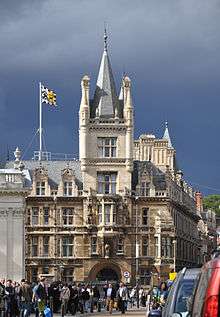 Gonville & Caius College from King's Parade | |||||
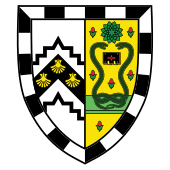 Arms of Gonville & Caius College | |||||
| Location | Trinity Street (map) | ||||
| Coordinates | 52.2059°N 0.1179°E | ||||
| Abbreviation | CAI[1] | ||||
| Founders |
| ||||
| Established | 1348, refounded 1557 | ||||
| Previous names |
| ||||
| Sister college | Brasenose College, Oxford | ||||
| Master | Pippa Rogerson | ||||
| Undergraduates | 475 | ||||
| Postgraduates | 230 | ||||
| Endowment | £227.5m (as of 30 June 2019)[2] | ||||
| Website | www | ||||
| Boat club | www | ||||
| Map | |||||
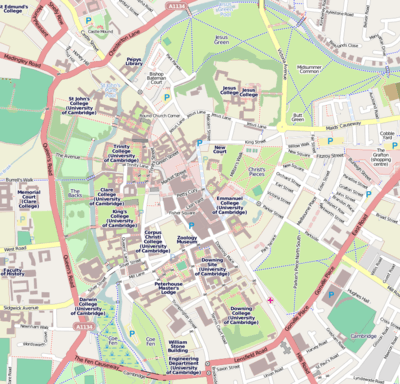 Location in Central Cambridge | |||||
The college has long historical associations with medical teaching, especially due to its alumni physicians: John Caius (who gave the college the caduceus in its insignia) and William Harvey. Other famous alumni in the sciences include Francis Crick (joint discoverer, along with James Watson, of the structure of DNA), James Chadwick (discoverer of the neutron) and Howard Florey (developer of penicillin). Stephen Hawking, previously Cambridge's Lucasian Chair of Mathematics Emeritus, was a fellow of the college until his death in 2018.[6] The college also maintains reputable academic programmes in many other disciplines, including law, economics, English literature and history.
Several streets in the city, such as Harvey Road, Glisson Road and Gresham Road, are named after alumni of the College.[7] The college and its masters have been influential in the development of the university, founding other colleges like Trinity Hall and Darwin College and providing land on the Sidgwick Site, e.g. for the Squire Law Library.
History
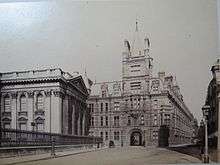
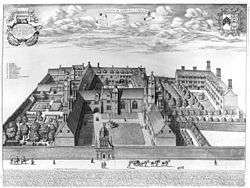
The college was first founded, as Gonville Hall, by Edmund Gonville, Rector of Terrington St Clement in Norfolk in 1348, making it the fourth-oldest surviving college. When Gonville died three years later, he left a struggling institution with almost no money. The executor of his will, William Bateman, Bishop of Norwich, stepped in, transferring the college to its current location. He leased himself the land close to the river to set up his own college, Trinity Hall, and renamed Gonville Hall The Hall of the Annunciation of the Blessed Virgin Mary. Bateman appointed as the first Master of the new college his former chaplain John Colton, later Archbishop of Armagh.
By the sixteenth century, the college had fallen into disrepair, and in 1557 it was refounded by Royal Charter as Gonville & Caius College by the physician John Caius.[8] John Caius was master of the college from 1559 until shortly before his death in 1573. He provided the college with significant funds and greatly extended the buildings.
During his time as Master, Caius accepted no payment but insisted on several unusual rules. He insisted that the college admit no scholar who "is deformed, dumb, blind, lame, maimed, mutilated, a Welshman, or suffering from any grave or contagious illness, or an invalid, that is sick in a serious measure".[9] Caius also built a three-sided court, Caius Court, "lest the air from being confined within a narrow space should become foul". Caius did, however, found the college as a strong centre for the study of medicine, a tradition that it aims to keep to this day.
By 1630, the college had expanded greatly, having around 25 fellows and 150 students, but numbers fell over the next century, only returning to the 1630 level in the early nineteenth century. Since then the college has grown considerably and now has one of the largest undergraduate populations in the university. The college first admitted women as fellows and students in 1979. It now has over 110 Fellows, over 700 students and about 200 staff.
Gonville & Caius is one of the wealthiest of all Cambridge colleges with an endowment of £221 million in 2018.[10]
The college's present Master, the 43rd, is Pippa Rogerson.[11]
Buildings and grounds
Old Courts

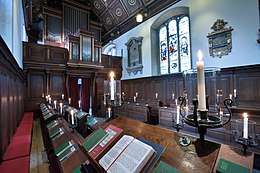
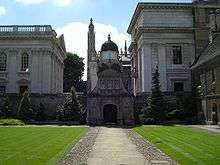
The first buildings to be erected on the college's current site date from 1353 when Bateman built Gonville Court. The college chapel was added in 1393 with the Old Hall (used until recently as a library) and Master's Lodge following in the next half century. Most of the stone used to build the college came from Ramsey Abbey near Ramsey, Cambridgeshire. Gonville and Caius has the oldest purpose-built college chapel in either Oxford or Cambridge which has been in continuous use as such. The chapel is situated centrally within the college, reflecting the college's religious foundation.[12]
On the re-foundation by Caius, the college was expanded and updated. In 1565 the building of Caius Court began, and Caius planted an avenue of trees in what is now known as Tree Court. He was also responsible for the building of the college's three gates, symbolising the path of academic life. On matriculation, one arrives at the Gate of Humility (near the Porters' Lodge). In the centre of the college one passes through the Gate of Virtue regularly. And finally, graduating students pass through the Gate of Honour on their way to the neighbouring Senate House to receive their degrees. The Gate of Honour, at the south side of Caius Court, though the most direct way from the Old Courts to the College Library (Cockerell Building), is only used for special occasions such as graduation. The students of Gonville and Caius commonly refer to the fourth gate in the college, between Tree Court and Gonville Court, which also gives access to some lavatories, as the Gate of Necessity.
The buildings of Gonville Court were given classical facades in the 1750s, and the Old Library and the Hall were designed by Anthony Salvin in 1854. On the wall of the Hall hangs a college flag which in 1912 was flown at the South Pole by Cambridge's Edward Adrian Wilson during the famous Terra Nova Expedition of 1910–1913. Gonville Court, though remodelled in the eighteenth and nineteenth centuries, is the oldest part of the college. New lecture rooms were designed by Alfred Waterhouse and completed by Rattee and Kett in 1884.[13]
.jpg)
Tree Court is the largest of the Old Courts. It is so named because John Caius planted an avenue of trees there. Although none of the original trees survive, the court retains a number of trees and the tree-lined avenue, which is unusual for a Cambridge front court.
West Road site
Caius owns a substantial amount of land between West Road and Sidgwick Avenue. Set in landscaped gardens, the modern Harvey Court (named after William Harvey and designed by Leslie Martin) was built on the West Road site in 1961. Adjacent to Harvey Court is the Stephen Hawking Building, which opened its doors to first-year undergraduates in October 2006. Providing ensuite accommodation for 75 students and eight fellows, as well as providing conference facilities in the vacations, the Stephen Hawking Building boasts some of the highest-standard student accommodation in Cambridge.
Additional buildings provide housing for older students, a day care, and various study and music rooms. The college also owns extensive gardens and the land on which the adjacent Squire Law Library has stood since 1995.
Library
Caius also has one of the largest libraries in Oxbridge, housed in the Cockerell Building.[14] Caius acquired the lease on the building, which previously housed the Seeley History Library and the Squire Law Library, in the 1990s. The college library was relocated there from Gonville Court in the summer of 1996, following an extensive renovation.
Other courts and college accommodation
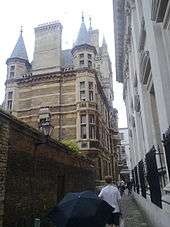
These courts are across Trinity Street on land surrounding St Michael's Church. St Michael's Court was completed only in the 1930s, with the building on its south side of a new building overlooking the Market Place.
The college also owns several houses around Cambridge, on Mortimer Road and Gresham Road, where some second year undergraduates live, and on Harvey Road and St Paul's Road, which are occupied by graduate students.
Grounds
The Fellows' garden lies just beyond Harvey Court, on Sidgwick Avenue. The extensive sports fields are located on Barton Road, a few minute's walk from Harvey Court.
Traditions
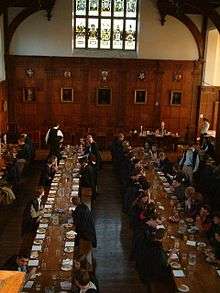
Gonville and Caius College maintains many traditions, and is unusual in that it offers two seatings in Hall six nights a week. Typically attended by between 200–300 students, Hall consists of a three-course meal served after 18:00 (First Hall) or 19:15 (Formal Hall); Formal Hall requires a gown be worn, also seats Fellows at high table, and is preceded by the benediction:
Benedic, Domine, nobis et donis tuis quae ex largitate tua sumus sumpturi; et concede ut, ab iis salubriter enutriti, tibi debitum obsequium praestare valeamus, per Jesum Christum dominum nostrum; mensae caelestis nos participes facias, Rex aeternae gloriae.[15]
As at most Oxbridge colleges, it is tradition that only the Fellows may walk on the grass.[16]
The college also enforces the system of "exeats", or official permissions to leave the college. Students wishing to be absent from college overnight during term time must obtain leave to do so from their tutors, and "terminal exeats" must be obtained before the end of term.[17]
Student life
Caius Boat Club is the college's boat club, with the men's 1st VIII remaining unbeaten in the seasons of 2010/11 and of 2011/2012, and (as of 2019) is currently in possession of both the Lent and May Bumps headships.
Caius Jazz takes place most terms in the college bar, inviting 'some of the most illustrious names in the contemporary scene' and a house band of students studying at London conservatoires to play in the college bar.[18] In recent years Steve Fishwick, Sam Mayne, Ian Shaw, Barry Green, Gareth Lockrane, and Paul Jarvis have all been featured.
The Caius May Ball is an all-night party in June, held every two years.
Choir
The choir was founded by the composer Charles Wood in the late nineteenth century, and was most recently directed by the scholar of South-American choral music, Geoffrey Webber until his resignation in 2019. The choir tours abroad and records eclectically. The choir is made up from Scholars and Exhibitioners from the college, and a few volunteers from other colleges.[19]
JCR
The college currently has a GCSU (Gonville and Caius Student Union). Francesca Hunt is the current president. [20]
Notable members
Nobel Prize laureates
- 1932 Charles Scott Sherrington – neurophysiologist (student and fellow).
- 1935 James Chadwick – physicist, discoverer of the neutron (student, fellow and master).
- 1945 Howard Florey – co-developer of penicillin (fellow).
- 1954 Max Born – physicist.
- 1962 Francis Crick – discovery of the structure of DNA (PhD student and honorary fellow).
- 1972 John Hicks – economist (fellow).
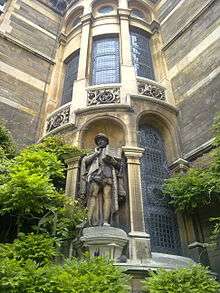 Statue of Stephen Perse, founder of the Perse School in Cambridge, set into the north-east corner of the Waterhouse Building
Statue of Stephen Perse, founder of the Perse School in Cambridge, set into the north-east corner of the Waterhouse Building - 1974 Antony Hewish – astronomer (student and fellow).
- 1976 Milton Friedman – economist (visiting fellow).
- 1977 Nevill Francis Mott – theoretical physicist (fellow and master).
- 1984 Richard Stone – economist.
- 2001 Joseph Stiglitz – economist (fellow).
- 2008 Roger Tsien – chemist (fellow).
- 2013 Michael Levitt – chemist (PhD student and research fellow).
- 2016 Michael Kosterlitz – physicist.
- 2019 Peter J. Ratcliffe – physician-scientist (student).
Notable alumni
Notable fellows and masters
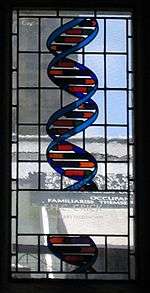
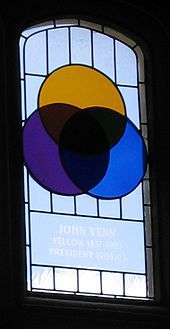
- Edward Hall Alderson – mathematician, classicist, lawyer and judge (student and fellow).
- T. C. Anand Kumar – reproductive biologist and the creator of the first scientifically documented test tube baby in India (fellow).
- Peter Bayley – Drapers Professor of French (fellow).
- Victoria Bateman (née Powell) - economist, feminist; known for her nude appearances in public.
- Peter Thomas Bauer – economist (student and fellow).
- Charles Brink – classicist, Kennedy Professor of Latin (1954–74) (fellow).
- Alastair Campbell – Downing Street Press Secretary (student and fellow).
- Roger Carpenter – neurophysiologist (fellow).
- James Chadwick – Nobel Prize-winning physicist, discoverer of the neutron (student, fellow, and Master).
- John Colton – Lord Chancellor of Ireland and Archbishop of Armagh (first Master).
- Francis Crick – co-Nobel Prize winner for the co-discovery of the structure of DNA (PhD student and honorary fellow).
- David Daube – the twentieth century's preeminent scholar of ancient law (fellow).
- Alfred Doll-Steinberg (1933–2012) – Austrian-born British chemical engineer[21]
- M. J. Farrell – economist (fellow).
- Alan Fersht – chemist and Fellow of the Royal Society (student, fellow, and Master).
- Thomas Fink, physicist and author (fellow).
- Ronald Fisher – statistician, evolutionary biologist, and geneticist (student, fellow, and President).
- Howard Florey – Nobel Prize-winning co-inventor of penicillin (fellow).
- James Fox – art historian and broadcaster (fellow).
- Milton Friedman – Nobel Prize-winning economist (visiting fellow).
- Francis Glisson – physician, and one of the founders of the Royal Society (fellow).
- John Hartstonge – Bishop of Derry (fellow).
- Stephen Hawking – theoretical physicist and former Lucasian Professor (fellow).
- Antony Hewish – Nobel Prize-winning astronomer (student and fellow).
- John Hicks – Nobel Prize-winning economist (fellow).
- Edmund Hickeringill – churchman (fellow)
- Robin Holloway – composer (fellow).
- Sarah Howe – poet (fellow).
- William Lubbock – divine.
- Stephen Mangan – actor
- Nevill Mott – Nobel Prize-winning theoretical physicist (fellow and Master).
- M. M. Pattison Muir – chemist (fellow).
- Joseph Needham – sinologist (student, fellow, and Master).
- Stephen Perse – founder of The Perse School in 1615.
- J. H. Prynne – poet (student and fellow).
- Jonathan Sacks – Chief Rabbi of British Commonwealth (fellow).
- Mohamed Suffian Mohamed Hashim – Chief Justice of Malaysia (student and fellow).
- John Seeley – Regius Professor of Modern History at Cambridge (fellow).
- D.R. Shackleton Bailey – classicist (student and fellow).
- Charles Sherrington – Nobel Prize-winning neurophysiologist (student and fellow).
- Quentin Skinner – Regius Professor of Modern History at Cambridge (student and fellow).
- Joseph Stiglitz – Nobel Prize-winning economist (fellow).
- John Venn – inventor of the Venn diagram and historian of the College (student, fellow, and President).
- Peter Tranchell – composer (fellow).
- William Wade – English academic lawyer (student and Master).
- Joachim Whaley – German and Dutch historian. Pilkington Teaching Prize, 2010.
- Charles Wood – composer (fellow).
- Edward Wright – mathematician and cartographer who first explained the mathematical basis for the Mercator projection (student and fellow).
Notable organ scholars
- Heathcote Dicken Statham (1908–1911)
Burials
Gallery
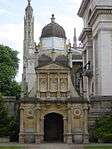 The Gate of Honour
The Gate of Honour Dining Hall
Dining Hall Fellow Dining Room
Fellow Dining Room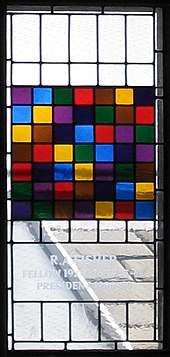 Stained glass window in dining hall
Stained glass window in dining hall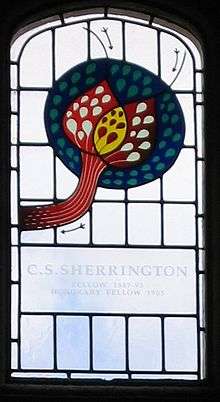 Stained glass window in dining hall
Stained glass window in dining hall Stained glass window in dining hall
Stained glass window in dining hall Stained glass window in dining hall
Stained glass window in dining hall View from Great St Mary's Church
View from Great St Mary's Church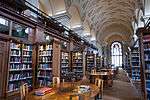 The library
The library.jpg) The boathouse
The boathouse College crest
College crest
References
- University of Cambridge (6 March 2019). "Notice by the Editor". Cambridge University Reporter. 149 (Special No 5): 1. Retrieved 20 March 2019.
- "Trustee's Annual Report and Accounts for the year ended 30 June 2018" (PDF). Gonville and Caius College, Cambridge. Retrieved 30 July 2019.
- "College History – Caius College Cambridge". Gonville & Caius College. Archived from the original on 16 July 2012. Retrieved 28 August 2012.
- "College Research – Caius College Cambridge". Gonville & Caius College. Retrieved 16 November 2012.
- "Nobel Prize Winners – Research – University of Cambridge". University of Cambridge. Retrieved 6 October 2012.
- "The Stephen Hawking Building – Gonville & Caius". Gonville & Caius College. Retrieved 13 September 2014.
- Brooke, Christopher A History of Gonville & Caius College (Rochester, 1985), p. 225, n10.
- "History – Gonville & Caius". Gonville & Caius College. Retrieved 13 September 2014.
- Brooke, Christopher A History of Gonville & Caius College p. 69–70, where it is suggested that 'Wallicum' is a scribal error for 'Gallicum'
- https://www.cai.cam.ac.uk/discover/strategy-and-policies/finance-and-annual-reports
- "Master and Fellows – Gonville & Caius". Gonville & Caius College. Retrieved 13 September 2014.
- "Wayback Machine". 17 May 2014. Archived from the original on 17 May 2014.
- Venn, John (1901). Biographical History of Gonville and Caius College. Cambridge University Press. p. 148.
- "Gonville and Caius Library Tour". Archived from the original on 6 July 2009. Retrieved 14 July 2009.
- "What is a Cambridge College?". The Collegiate Way: Residential Colleges & the Renewal of University Life. Retrieved 16 October 2010.
- "College Regulations and General Information" (PDF). Gonville & Caius College, Cambridge. 2008–2009. pp. ix. Archived from the original (PDF) on 16 June 2009.
- "College Regulations and General Information" (PDF). Gonville & Caius College, Cambridge. 2008–2009. pp. iv. Archived from the original (PDF) on 1 April 2011. Retrieved 20 July 2010.
- Liz Enin (1 March 2010). "Review: Caius Jazz". The Tab Cambridge. Archived from the original on 18 May 2014. Retrieved 13 September 2014.
- "Choir – Gonville & Caius". Gonville & Caius College. Retrieved 13 September 2014.
- , Gonville and Caius Updates
- "Alfred Doll-Steinberg". The Daily Telegraph. 11 June 2012. Retrieved 18 April 2017.
Bibliography
- Brooke, C. A history of Gonville and Caius College. Woodbridge, Suffolk: Boydell, 1985 (corrected reprint, 1996). ISBN 0-85115-423-9.
External links
| Wikimedia Commons has media related to Gonville and Caius College, Cambridge. |
